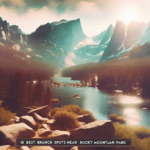Introduction
Ever been captivated by pictures of Iceland’s stunning landscapes or enthralling midnight sun and wondered when to visit or what regions to explore? Well, you’re not alone. This article breaks down the best regions to make your stay in Iceland worth your while. From the vibrant capital, Reykjavik, to the tranquil and pristine landscapes of North Iceland and the raw beauty of East and West Fjords, you’ll get a comprehensive guide to help you make your selection.
But that’s not all. We also dive into the prospect of visiting Iceland during the summer months – is it worth considering? And a very crucial question for budget travelers – is Iceland cheaper in summer? Let’s explore!
Ready for an Icelandic adventure? Dive in!
Picking Your Ideal Spot in Iceland
Iceland, a country known for its miraculous landscapes, offers a plethora of choices for the traveler. But deciding where to stay can be a hard nut to crack. While each region of Iceland has its unique charm, your choice boils down to your interests and what you intend to explore. Here, we explore some of the best regions to make your stay in Iceland memorable.
Reykjavik: The Vibrant Capital
Reykjavik, the capital of Iceland, offers a rich blend of cultural and social life. With a plethora of cafes, shops, and museums, it gives a modern city feel amidst the tranquil Icelandic environment.
The city is the country’s heartbeat, and it makes for an excellent base if you’re looking forward to exploring the Golden Circle or attending local music and art festivals.
Key Reasons to Stay in Reykjavik:
- Proximity to the Golden Circle and Blue Lagoon
- Rich nightlife and cultural scene
- A variety of options for accommodations
The South Coast: A Blend of Natural Wonders
Waterfalls, glaciers, beautiful beaches – the South Coast has it all. This region is home to some of Iceland’s most stunning landscapes.
Whether you’re an outdoor enthusiast or a romantic soul, the South Coast will not disappoint. With its accessible location and a range of accommodations, it is one of the favorite spots for many visitors.
Points of Attraction in the South Coast:
- Unforgettable sights of Skógafoss and Seljalandsfoss waterfalls
- Incredible glacier lagoon, Jokulsarlon
- Black sand beach, Reynisfjara
West Iceland and Snaefellsnes Peninsula: Hub of Natural Diversity
The West region, specifically the Snaefellsnes Peninsula, is famously dubbed as “Iceland in Miniature”. It is because it features a little bit of everything that Iceland has to offer.
From wildlife viewing and lava fields to small fishing villages and ancient waterfalls, this region offers a rich palette of experiences.
Highlights of West Iceland:
- The strikingly beautiful Snaefellsjokull National Park
- Kirkjufell, the most photographed mountain in Iceland
- The historical settlement of Stykkisholmur
Each of these regions has its unique traits that can make your stay in Iceland a once-in-a-lifetime adventure. It’s just about picking the right spot that aligns with your interests. Remember, there are no wrong choices when you’re in a place as breathtaking as Iceland.
Iceland in the Summer: An Experience Worth Considering
Considered a destination for all seasons, Iceland offers a different charm during the summer months. From enjoying long hours of daylight to engaging in outdoor activities that come alive in the warmth, summer in Iceland has its own allure. Let’s delve into what you can expect when visiting this North Atlantic oasis during the balmy months.
Midnight Sun: A Spectacular Phenomenon
Iceland is synonymous with the Midnight Sun during summer. Between late May and early August, the sun barely sets, providing nearly 24 hours of daylight. This not only means extra time to explore the stunning landscapes but also provides a unique opportunity to witness the night sky bathed in a surreal warm glow.
Advantages of the Midnight Sun:
- Extended daylight hours for sightseeing
- Unique photography opportunities
- Enchanting nights under a glowing sky
Outdoor Pursuits: Nature at Its Best
The summer warmth in Iceland awakens the country’s mesmerizing nature. Flora and fauna thrive, filling the landscape with vibrant hues and bustling life. Hiking, bird-watching, and whale-watching are popular activities during summer, not to mention exploring hidden trails and unpaved roads that are inaccessible in winter.
Summer-specific Activities in Iceland:
- Exploring lesser-known trails
- Visiting puffin colonies in the West and North
- Whale watching in Husavik or Akureyri
Festivals and Events: Soaking in the Icelandic Culture
Summer also marks the time of vibrant festivals in Iceland. From nation-wide celebrations of the National Day to quirky small-town festivals, summer is the perfect window to immerse in Iceland’s unique culture. Add to this the endless daylight, and the festivals turn into round-the-clock events that are both enlightening and fun.
Popular Summer Events in Iceland:
- Iceland’s National Day celebrations
- Musical events like Secret Solstice Festival
- Peculiar festivals like the Dalvik Fiskidagurinn Mikli (Great Fish Day)
In a nutshell, visiting Iceland in summer guarantees a unique blend of natural beauty, engaging activities, and cultural celebrations. However, it’s advisable to book accommodations and car rentals ahead of time due to the season’s popularity. Remember, the magic of Iceland lies in its diversity, and summer offers an alluring perspective of this incredible destination.
Exploring the Northern Icelandic Treasures
The North of Iceland is arguably the most overlooked region of the country by tourists. However, its tranquility and pristine landscapes make it a real gem for those looking to enjoy an authentic Icelandic experience. From whale watching in Husavik to bathing in natural hot springs, the northern region offers a delightful blend of culture and nature.
Husavik: The Whale Watching Capital
Charming Husavik, known as the whale watching capital of Iceland, guarantees an unforgettable encounter with marine mammals. Husavik’s calm waters and the close proximity to the Arctic Circle make it a hotspot for various whale and dolphin species.
You can complement your whale-watching experience with a visit to the Whale Museum, for a comprehensive insight into these magnificent creatures.
Why Husavik is a Must-visit:
- Excellent whale and dolphin sightings
- Informative Whale Museum
- Geosea Geothermal Sea Baths, offering stunning sea views
Myvatn: A Geothermal Paradise
The Myvatn Lake area is a geothermal wonderland, adorned with pseudo-craters, lava pillars, and bubbling mud pools. Bird watchers would particularly enjoy Myvatn for its abundant bird life, with the lake being home to various duck species.
And after a day of exploration, what could be better than relaxing at the natural hot springs of Myvatn Nature Baths?
Fascinating Attractions in Myvatn:
- The eerie Dimmuborgir lava formations
- The colorful Namaskard geothermal area
- Myvatn Nature Baths, Iceland’s answer to the Blue Lagoon
Akureyri: Iceland’s Second City
Akureyri, often referred to as Iceland’s second city, is the largest urban area in the north. Apart from offering an array of restaurants and shops, Akureyri serves as the perfect base for exploring the surrounding nature like the Godafoss waterfall.
During winter, Akureyri’s ski resort comes alive, offering a unique option for winter sports enthusiasts in the region.
Top Features of Akureyri:
- Convenient location for visiting prominent natural sites
- Buzzing urban life with a small-town charm
- Great skiing opportunities in winter
The sparsely populated northern region of Iceland offers the perfect environment for enjoying the country’s natural beauty unimpeded. Its tranquil atmosphere combined with its stunning landscapes make it well worth the visit. Therefore, when planning your Iceland adventure, allocating some time to the north could lead to some of your most memorable experiences.
Iceland’s Hidden Gems: The East and West Fjords
Far from the tourist central of the Golden Circle, the East and West Fjords of Iceland offer raw beauty and unique experiences. From dramatic fjords to remote fishing villages, these regions allow you to disconnect from the world and reconnect with nature.
West Fjords: Wild and Untouched
The West Fjords, the oldest part of Iceland, are characterized by rugged landscapes and abundant wildlife. The region is renowned for bird cliffs where several species, including the charming puffins, reside.
The West Fjords are also home to Dynjandi, regarded as one of the most beautiful waterfalls in Iceland.
Reasons to Visit the West Fjords:
- Beautiful landscapes with minimal tourist traffic
- Wildlife watching at Latrabjarg bird cliffs
- Impressive Dynjandi Waterfall
East Fjords: Icelandic Serenity at Its Best
Offering an excellent mix of mountains, sea, and charming towns, the East Fjords are nothing short of magical. Seydisfjordur, a picturesque town located in one of the fjords, is famous for its artist community and vibrant culture.
Furthermore, the region is ideal for hiking enthusiasts, with its varied terrain and numerous trails.
Bucket List Experiences in the East Fjords:
- Visiting the vibrant town of Seydisfjordur
- Exploring the oldest settlement in Iceland, Stodvarfjordur
- Hiking adventures in the dramatic landscapes
Venturing into the East and West Fjords of Iceland provides stunning vistas and unparalleled tranquility. These regions encapsulate the sense of adventure that many seek when visiting Iceland. Therefore, if you wish to stray from the beaten path, including the fjords in your itinerary will insure an enriching Icelandic experience.
Is Iceland Cheaper in Summer?
One of the crucial factors that travelers should consider when planning a trip to Iceland is the potential cost. Many presume that visiting Iceland in summer would be more expensive due to increased tourist traffic. However, the actual scenario may surprise you.
Accommodation Prices: A Catch-22 Situation
Hotels in popular Icelandic regions often increase their rates during the summer months due to higher demand. This may give the impression that summer travel is pricier. However, the increased accommodation options available during this season, including camping and budget hostels, can balance out the increased costs.
Accommodation Cost Considerations in Summer:
- Higher hotel prices due to increased demand
- More budget-friendly options available like hostels and campsites
- Booking in advance can help secure affordable rates
Car Rentals: Deal or No Deal?
Most tourists rent cars for exploring Iceland, especially its countryside. Similar to accommodation, car rental prices may also peak during the summer. However, you could also find special deals and discounts if you book well in advance. Furthermore, during summer, 2WD cars would suffice for most tourist routes, which could significantly lower your rental costs compared to winter when 4WD vehicles are often required.
Car Rental Factors in Summer:
- Potential for increased costs due to demand
- Possibility of discounts with early booking
- Savings on rental costs with 2WD vehicles being adequate for most routes
Food and Dining: A Mixed Bag
The cost of dining in Iceland might not significantly fluctuate between seasons. However, summer provides an opportunity to save on meals. With long daylight hours, you may find yourself eating less often, and the possibility of outdoor picnics or BBQs can also cut down on your food expenses.
Summer Dining Cost Prospects:
- No significant seasonal changes in restaurant prices
- Opportunity for fewer and cheaper meals due to extended daylight hours
- Possibility of saving on food expenses with outdoor self-catering options
Activities and Sightseeing: More Bang for Your Buck
Summer opens up a wealth of outdoor activities in Iceland, such as hiking, bird watching, whale watching, and exploring offbeat trails. While some of these activities might come with a fee, many, like hiking or exploring the landscapes, are free. Combined with the extended daylight hours, you’re likely to get more value for your money during the summer months.
Affordable Summer Activities:
- Free outdoor activities like hiking and sightseeing
- Extended daylight hours for longer exploration
- Reduced need for guided tours due to favorable weather conditions
Summing Up: Is Summer in Iceland Cost Effective?
While you might face increased costs in certain areas like accommodation and car rentals during summer, they can be balanced out with other savings. The plentiful budget-friendly accommodation options, the savings on car rentals, and the abundance of free or cost-effective activities make the summer season a viable choice for budget-conscious travelers. Booking early is key for securing the best deals. Ultimately, the decision boils down to factors like your comfort, preferences, and budgetary constraints.
Concluding Thoughts
In conclusion, Iceland is a destination filled with wonder and adventure, regardless of the time of year or region you choose to visit. You can immerse yourself in the cultural buzz of Reykjavik, experience the untouched beauty of the East and West Fjords, or unwind in the tranquility of the North. Conversely, if you decide to visit during the summer, despite the potential increase in certain costs, there are ways to maintain an affordable visit while taking full advantage of longer days and additional activities. Regardless of when or where you choose to go, a trip to Iceland promises an enriching and unforgettable experience.
Is Reykjavik a good base for exploring Iceland?
Yes, Reykjavik is a great base due to its proximity to many popular sites like the Golden Circle and Blue Lagoon. Moreover, it offers a vibrant nightlife and a rich cultural scene.
What can I expect if I visit Iceland during the summer?
In summer, you can enjoy nearly 24 hours of daylight, warm weather, and a wealth of outdoor activities. Additionally, there are vibrant festivals and events that allow you to immerse in Icelandic culture.
Are the East and West Fjords worth visiting?
Absolutely! The East and West Fjords offer stunning landscapes, tranquility, and a chance to explore the less touristy parts of Iceland. They are perfect for travelers seeking to disconnect from the world and reconnect with nature.
Is it cost-effective to visit Iceland in the summer?
While some costs – like accommodation and car rentals – might be higher during summer, they can be balanced by savings in other areas. You can find budget-friendly accommodation options, save on car rentals, and participate in numerous free or cost-effective activities. Booking early is key to securing the best deals.







